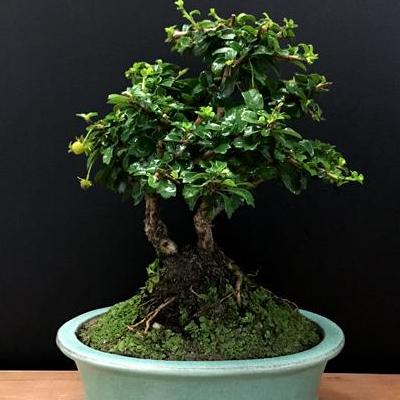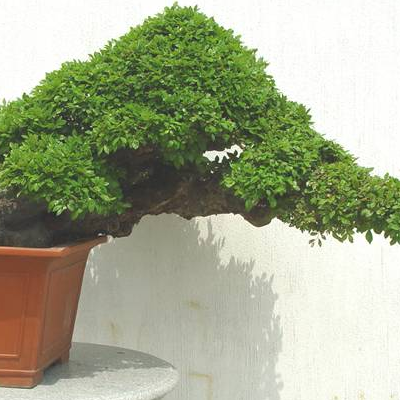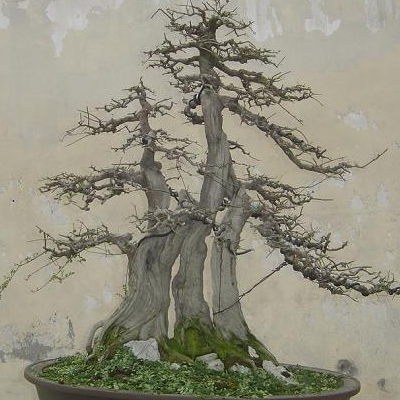How does Fujian tea bonsai shape? how much is the price?
Fujian tea bonsai, this kind of bonsai is a lot of people like farming, this Fujian tea bonsai to grow into a fixed appearance is the need to shape, Fujian tea bonsai how to shape? What is the price of Fujian tea bonsai:

How to shape Fujian tea bonsai:
To make Fujian tea bonsai, one-year-old branches or semi-lignified branches with strong growth can be selected for cutting propagation in spring or plum rain season, and seedlings can also be obtained by root propagation from early summer to early autumn. in the south, wild stumps or young trees can also be dug in the woods and processed to pot after raising blanks to survive.
Fujian tea is very strong in growth and resistant to pruning, so it is suitable to use the method of "storing branches and cutting dry" adopted by Lingnan bonsai, so that the branches can achieve the effect of natural twists and turns and vigorous power by pruning many times. Common tree shapes are straight dry type, double dry type, oblique dry type, multi-dry type, jungle type, cliff type, stone-attached type and so on.
Fujian tea is an evergreen shrub with dense branches, including big leaves, middle leaves and leaflets. Among them, Fujian tea with lobular leaves has slow growth, small leaves, dark green, bright and lovely, well-developed roots, intertwined roots, quaint posture and lovable.
Fujian tea has strong sprouting ability and resistance to pruning, so it is often made into natural tree-shaped bonsai by the method of "storing branches and cutting dry". That is, the young trees used for bonsai grow to a certain thickness, carry out intensity cutting (cutting off most of the trunk), and retain 1 ~ 2 or 3 ~ 5 branches as first-class lateral branches at appropriate parts and angles. when the upper second-grade branches grow to a certain thickness, retain one or two branches and cut short to promote the growth of the third-grade branches; in turn, year after year, cut off and accumulate branches.
When the branches and leaves are too dense, in addition to cutting off the overgrown branches at any time, they will be pruned once a year in early summer and Mid-Autumn Festival. Pruning should also be carried out according to the method of "storing branches and cutting dry". After a few years of pruning, it will be cultivated into bonsai with vigorous and clumsy trunk, whirling branches and leaves, and beautiful tree shape.
Price of Fujian tea bonsai:
If you don't want to make Fujian tea bonsai yourself, you can also choose to buy it. Fujian tea bonsai is not expensive, tens to hundreds of yuan per plant. Let's take a look at some examples to learn about it.
(1) the height of Fujian tea in Wanglin horticulture is between 15cm-20cm and the reference price is 32 yuan.
(2) Jingruxuan 6 years Fujian tea bonsai, the height is between 40cm-50cm, the reference price is 129yuan.
(3) Flower Friends Home Fujian tea bonsai + rockery, the height is between 20cm-25cm, the reference price is 88 yuan.
Fujian tea bonsai prices are different, according to their own preferences to choose the height of the size.
This is the end of the modeling method and price of Fujian tea bonsai. Hurry up and have one in your own home.
The production of miniature bonsai
The production of miniature bonsai
The plant bonsai is calculated by the unearthed height of the plant, and the landscape bonsai is calculated by the length of the pot. those less than 10 centimeters are miniature bonsai. The characteristics of miniature bonsai: small size, small footprint, light weight, short time from planting modeling to viewing, and low price.
The concept and production of miniature bonsai are basically the same as those of general landscape bonsai or plant bonsai. Miniature bonsai because the basin is small, the plants used should be small branches and leaves, strong adaptability, the shape is not too complex. The maintenance method is basically the same as the general bonsai, but it needs to be managed more carefully.
Miniature bonsai is small in size, and a single display appears monotonous and small. generally, several pieces are placed on the Bogu shelf. it is best to put different kinds of miniature bonsai plus 1-2 exquisite small handicrafts together in the Bogu shelf. there is a dazzling array, rich and colorful feeling.
Two miniature bonsai and Bogu shelves
① fan-shaped Bo ancient shelf. ② special-shaped Bo ancient shelf.
Miniature bonsai is small in shape, exquisite and exquisite, lively and changeable, and its layout is arbitrary. It can be placed on the desk or combined in the Bogu shelf, which realistically reflects the elegant demeanor of Dazhen and is highly appreciated.
one。 The most suitable material for miniature pots
1. Miniature bonsai plants are no more than 10 centimeters high (calculated on the basis of unearthed plants). The selected plant materials should have the characteristics of small leaves, thick and short stem, strong adaptability, resistance to pruning, easy modeling, easy survival, such as June snow, hammer elm, Finch plum, Fujian tea, etc. Gardenia jasminoides, Luohan pine, tiger thorn, melon seed yellow poplar, sparrow tongue yellow poplar, pearl yellow poplar, canary, small pomegranate, Berberis, small cycad, small banyan, small Phoenix tail bamboo, small chrysanthemum, golden marbles, black pine, Ying Shanhong, Guanyin bamboo, short dry asparagus, bayberry and so on.
two。 For the mountains and rocks of miniature landscape bonsai, it is better to have beautiful texture, natural shape, moist color, long strips and angles, such as caves on the rocks. The commonly used stone species are wood fossils, Yingde stone, axe split stone, seaweed stone, pumice stone, Reed stone, stalactite and so on.
Second, the most gold used in miniature basins
The miniature bonsai basin is smaller, the caliber of the cylinder basin should be 4cm, the diameter of the round basin or square basin is 5cm, and the caliber of the shallow rectangular or oval basin is 10cm.
Miniature plant bonsai, mostly using quaint purple sand basin or glazed pottery basin. The shape, depth and color of the basin should be coordinated with the planted plant materials in terms of leaf shape, leaf color and the color of flowers and fruits, and should be in close harmony with the posture of the stump scene of the trees. Life utensils can also be used as pots, such as ashtrays, teacups, small bowls, bird food cans, etc., but the bottom needs to be drilled to facilitate drainage, otherwise it is easy to cause plant roots to rot.
Miniature landscape bonsai, mostly shallow mouth long basin or oval basin, with white marble, bauxite texture more.
Third, the production of miniature bonsai the source of pile materials of micro-search plant basin table is mainly obtained by grafting, pole insertion, ramet, seedling cultivation, wild stump excavation, modeling using flat binding, pruning, root lifting and other methods. During the operation, it is required to be careful and fine, exquisite and exquisite, and strive to have the right skills and transport capacity, which can be shown on the branches and trunk, so that the small trees and twigs show the appearance of a "old tree" with a strong and calm temperament, so that the appearance form is skillfully combined with the inner temperament. Modeling should be simple rather than complicated, we should use freehand brushwork, pay attention to the performance of its catalpa state, so as to achieve the intersection of spirit and shape. After processing, the pile should be transplanted in a larger mud basin first, and then transplanted in a quaint small basin with suitable shape, size, depth and color after 1-2 years, so as to improve the survival rate.
The production of miniature landscape bonsai, including material selection,
Processing, layout, embellishment and so on, generally adopt the near mid-scene style in the heavy style, and we should pay attention to the comparison between the basin and the mountain peak and its beautiful artistic conception. Because the miniature landscape bonsai is small, it is difficult to find when it is moved. After the modeling is completed, it is best to use water-resistant glue to stick the rock on the basin surface.
On the Innovation of Lingnan Bonsai
Lingnan bonsai after nearly a hundred years, through the efforts of several generations of Lingnan bonsai artists, from embryonic to gradually mature, and finally set up a school of its own. Today, Lingnan bonsai has been recognized by the world, and its influence at home and abroad is growing. It has become the most dynamic, distinctive, potential and influential bonsai in the domestic bonsai world. Many foreign bonsai people have higher and higher evaluation of Lingnan bonsai.
▲ Yu Jingtu's work "all Birds return to the Nest" (Finch Plum, 120x70 × 80cm)
▲ Yu Jing Picture (Black Pine)
Lingnan is located in the subtropics, with high temperature, high humidity, abundant sunshine and abundant rainfall, which is suitable for all kinds of plants. Especially shrub trees can grow all the year round. For example, Luo Hansong, Jiuli Xiang, Fujian tea, sparrow plum, elm, kapok, banyan, mountain orange, Acacia, crape myrtle, five-leaf maple, triangular plum, red oak, red bull, yellow poplar, Masson pine, mountain pine, black pine, water pine, water horizontal branch, red fruit, tang pear, black bone incense, Bolan, Xiangnan, red poplar, spring flower, mountain wood, crab claw incense, full sky star, pomegranate, pepper wood, bird not night, two-sided needle and so on. These are good materials for Lingnan bonsai.
▲ Yu Jing Picture (Elm)
Works by ▲ Yu Jingtu (Fujian Tea, High 70cm)
Therefore, Lingnan bonsai is dominated by miscellaneous wood, supplemented by pine and cypress. The annual growth period of miscellaneous wood bonsai is long, and there is basically no hibernating period. although a small part of them have a receding period, the time is short, only about a month, so it is very suitable for the production method of Lingnan bonsai branch storage, strip and brocade. Pine and cypress grow slowly, especially cypress trees, whose branches are soft, not easy to produce cross-horn branches, and grow very slowly, so they are not suitable for making Lingnan bonsai.
▲ Yu Jingtu's works (Park Shu)
The biggest difference between Lingnan bonsai and domestic brother schools and foreign bonsai is that Lingnan bonsai artists make Lingnan bonsai according to the principle of Chinese painting. First of all, they make up their mind according to the hidden and exposed roots of the stump, the direction of the roots, and the shape of the trunk-what kind of bonsai will it be created in the future? Lingnan bonsai, like Chinese painting, pays attention to artistic conception. The author applies his creative ideas and emotional expression to the whole process of creating bonsai. In the process of creation, according to the trend and shape of roots, heads and tree trunks, the layout of brackets and branches and the position of the top are selected to deal with the relationship between care and hope, gathering and dispersing, receiving and releasing. After dealing with these relationships, a Lingnan bonsai has stomata (traditional Chinese painting is called blank), with distinct levels, strong three-dimensional sense, emotion in the scene, and attracting people's imagination. This is silent poetry and three-dimensional painting.
▲ Yu Jingtu's works (Finch Plum)
As Lingnan bonsai is created in accordance with the principle of traditional Chinese painting, it is very strict in the production process, one more stroke (one branch support), one less stroke will affect the effect of the whole bonsai.
Works by ▲ Yu Jingtu (Ziwei)
The main method of making Lingnan bonsai is to store branches and cut dry. If it is not cut dry, it is a big tree and cannot be made into bonsai ranging from tens of centimeters to more than one meter. Of course, branching and truncation is not limited to Lingnan bonsai, other schools and foreign bonsai production also use this method. However, the branch truncation of Lingnan bonsai is different from other schools in that it shrinks the supporting branches and distributed branches into inches. In the past, the old artists said that they cut three knives per inch. Due to the use of the production method of storing branches and shrinking the size of the dragon, it is produced according to the painting theory, from the selection of the bracket to the distribution of the branches and the layout of the whole bonsai.
▲ Yu Jingtu's work "readily available" (Finch Plum, Piaochang 70cm)
Cutting is to control the proportion of branches, from thick to thin paragraph by paragraph, like a painting, a piece is a stroke. The shrinking dragon is to manipulate the direction of the branches, leading the branches to a reasonable position according to the layout. Cheng-cun is short-speed and powerful, which makes the branch receptacle appear vigorous and powerful, revealing the support position and the trend of the branches, making it clear in layers. Lingnan bonsai shows more than it hides, so it takes time and great skill to create a mature Lingnan bonsai.
As Lingnan bonsai benefits from the unique climatic conditions of Lingnan region, and is created in accordance with the principle of traditional Chinese painting, using the production method of storing branches and truncating, shrinking and shrinking into inches, Lingnan bonsai can come from nature, but higher than nature. After the long-term unremitting efforts of bonsai artists, bonsai is created in a variety of forms.
From the early near-tree shape, the single form of dwarf trees, to the continuous creation of cliff type, water-facing type, oblique floating type, moon type, kapok type, cloud head and rain foot, and so on. From single plant to multi-stem and even forest type. Especially in the past two or three decades, he has created excellent bonsai with Lingnan characteristics, such as high falling branch, big stall branch, turning back branch and so on. Because these big branches do not grow at the top, not upward, but downward or horizontally, it is particularly difficult to cultivate. It grows slowly, but also has a certain roughness and change, so it takes a long time to cultivate. In cold areas, where the annual growth period of plants is short, it is very difficult to create bonsai with big falling branches, big floating branches and big spreading branches, and it is only in the south subtropics of the range that it is easy to cultivate and create such bonsai.
Stripping and changing brocade is another way to make Lingnan bonsai. Acacia, sparrow plum, Fujian tea, Jiuli incense and other tree species can be made two or three times a year, picking all the leaves, altering and cutting the branches. This method of stripping and changing brocade is to better store branches, sprout more buds to grow twigs, speed up the maturity of bonsai, and shorten its cultivation time. After undressing and changing brocade, the bonsai has changed. Although it is carried out in spring, summer and autumn, it makes people feel that there are no leaves on the plants after snow in winter, just like the winter scenery. And more importantly, because there are no leaves, only branches, each branch is like every stroke in the painting, a little messy, can see clearly, it is simply a meticulous painting.
Internationally, there are certain restrictions on the height of bonsai, which is less than one meter. However, people in Lingnan dare to innovate and keep pace with the times. with the improvement of people's living standards and changes in the home environment, more and more people live leniently and have gardens. Small bonsai can no longer meet the needs of their spacious environment, so in the past decade, Lingnan bonsai artists have begun to create large-scale bonsai. In Guangdong and other places, people have created many large-scale Lingnan bonsai of more than 1.5 meters. These large bonsai enter the villa area, the big garden, is very favored, and sells the price is high, the economic benefit is good. More and more people like large bonsai. Large bonsai is an important aspect of the future development of Lingnan bonsai.
- Prev

How to raise leaves of Fujian tea bonsai?
Fujian tea bonsai, this kind of bonsai is a lot of people like breeding, is such a pleasant, Fujian tea bonsai how to raise? Fujian tea pot scenery leaves how to do: Fujian tea bonsai how to raise: (1) place. Fujian tea likes to be warm and afraid of cold, if it is raised in the Yangtze River Basin and the northern region.
- Next

What is the price of the method of making tree stump bonsai?
Tree stump bonsai, this is also a kind of bonsai, this stump bonsai is not generally good-looking, what is the production method of tree stump bonsai? What is the price of tree stump bonsai: the production method of tree stump bonsai: 1. The shape of the bonsai of the stump is different, and the bending shape of its branches is also varied.
Related
- Fuxing push coffee new agricultural production and marketing class: lack of small-scale processing plants
- Jujube rice field leisure farm deep ploughing Yilan for five years to create a space for organic food and play
- Nongyu Farm-A trial of organic papaya for brave women with advanced technology
- Four points for attention in the prevention and control of diseases and insect pests of edible fungi
- How to add nutrient solution to Edible Fungi
- Is there any good way to control edible fungus mites?
- Open Inoculation Technology of Edible Fungi
- Is there any clever way to use fertilizer for edible fungus in winter?
- What agents are used to kill the pathogens of edible fungi in the mushroom shed?
- Rapid drying of Edible Fungi

